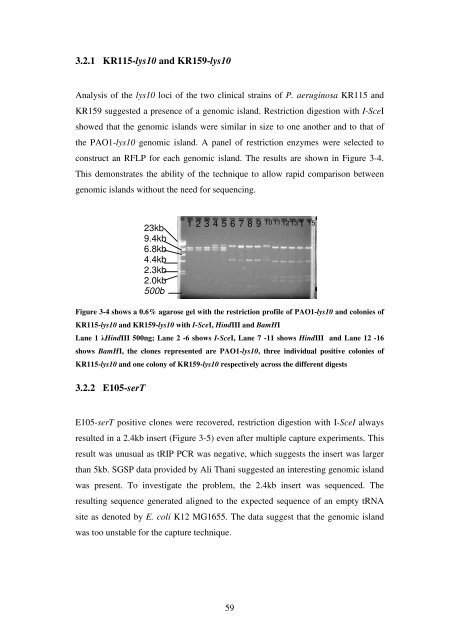5 The role of quorum-sensing in the virulence of Pseudomonas ...
5 The role of quorum-sensing in the virulence of Pseudomonas ...
5 The role of quorum-sensing in the virulence of Pseudomonas ...
You also want an ePaper? Increase the reach of your titles
YUMPU automatically turns print PDFs into web optimized ePapers that Google loves.
3.2.1 KR115-lys10 and KR159-lys10<br />
Analysis <strong>of</strong> <strong>the</strong> lys10 loci <strong>of</strong> <strong>the</strong> two cl<strong>in</strong>ical stra<strong>in</strong>s <strong>of</strong> P. aerug<strong>in</strong>osa KR115 and<br />
KR159 suggested a presence <strong>of</strong> a genomic island. Restriction digestion with I-SceI<br />
showed that <strong>the</strong> genomic islands were similar <strong>in</strong> size to one ano<strong>the</strong>r and to that <strong>of</strong><br />
<strong>the</strong> PAO1-lys10 genomic island. A panel <strong>of</strong> restriction enzymes were selected to<br />
construct an RFLP for each genomic island. <strong>The</strong> results are shown <strong>in</strong> Figure 3-4.<br />
This demonstrates <strong>the</strong> ability <strong>of</strong> <strong>the</strong> technique to allow rapid comparison between<br />
genomic islands without <strong>the</strong> need for sequenc<strong>in</strong>g.<br />
Figure 3-4 shows a 0.6% agarose gel with <strong>the</strong> restriction pr<strong>of</strong>ile <strong>of</strong> PAO1-lys10 and colonies <strong>of</strong><br />
KR115-lys10 and KR159-lys10 with I-SceI, H<strong>in</strong>dIII and BamHI<br />
Lane 1 λH<strong>in</strong>dIII 500ng; Lane 2 -6 shows I-SceI, Lane 7 -11 shows H<strong>in</strong>dIII and Lane 12 -16<br />
shows BamHI, <strong>the</strong> clones represented are PAO1-lys10, three <strong>in</strong>dividual positive colonies <strong>of</strong><br />
KR115-lys10 and one colony <strong>of</strong> KR159-lys10 respectively across <strong>the</strong> different digests<br />
3.2.2 E105-serT<br />
23kb<br />
9.4kb<br />
6.8kb<br />
4.4kb<br />
2.3kb<br />
2.0kb<br />
500b<br />
p<br />
E105-serT positive clones were recovered, restriction digestion with I-SceI always<br />
resulted <strong>in</strong> a 2.4kb <strong>in</strong>sert (Figure 3-5) even after multiple capture experiments. This<br />
result was unusual as tRIP PCR was negative, which suggests <strong>the</strong> <strong>in</strong>sert was larger<br />
than 5kb. SGSP data provided by Ali Thani suggested an <strong>in</strong>terest<strong>in</strong>g genomic island<br />
was present. To <strong>in</strong>vestigate <strong>the</strong> problem, <strong>the</strong> 2.4kb <strong>in</strong>sert was sequenced. <strong>The</strong><br />
result<strong>in</strong>g sequence generated aligned to <strong>the</strong> expected sequence <strong>of</strong> an empty tRNA<br />
site as denoted by E. coli K12 MG1655. <strong>The</strong> data suggest that <strong>the</strong> genomic island<br />
was too unstable for <strong>the</strong> capture technique.<br />
1 2 3 4 5 6 7 8 9 10 11 12 13 1 15<br />
59














